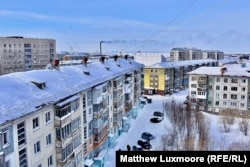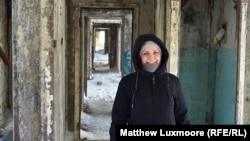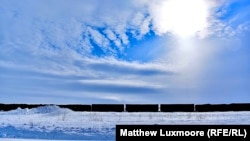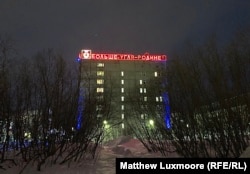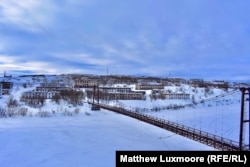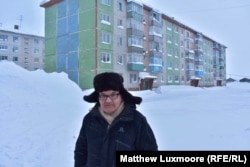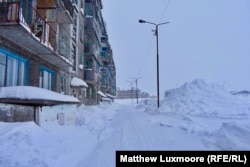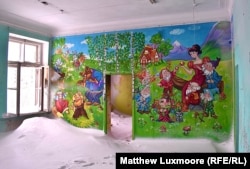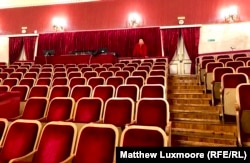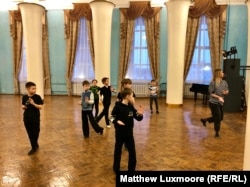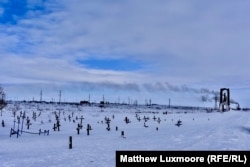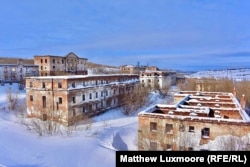VORKUTA, Russia — In May 1931, a group of 39 prisoners toiling in the Soviet Union’s expanding network of forced labor camps set off north from the town of Ukhta to explore the vast coal basin in the Russian Arctic.
Joined by a team of geologists and camp guards, the men traveled for weeks through barely navigable waters and icy tundra into the frigid, inhospitable region that would test the limits of the lauded Soviet conquest of the Far North.
They were soon joined by more prisoners, hundreds of whom died from sickness, hypothermia, and starvation. But by the spring of 1932, they founded Rudnik, a small coal-mining settlement 100 miles north of the Arctic Circle that would soon grow into the city of Vorkuta.
It had been a barren, forbidding terrain known only to indigenous Nenets reindeer herders; within a decade, it hosted one of the deadliest Gulag camps in the Soviet Union, and after Stalin’s death in 1953, a burgeoning metropolis that would be upheld as a symbol of Soviet power.
But close to a century after its founding, a city whose population approached 250,000 in the late 1980s now has fewer than 60,000 residents and is shrinking faster than any other in Russia. The communist slogans that adorn its buildings, promising a bright future, endure as symbols of the chasm between the utopian vision of the U.S.S.R. and its capacity to turn that vision into reality.
‘Widespread Abandonment’
“We all had an understanding in high school that we’d graduate and leave this place,” says Anastasia Sadvary, a 33-year-old legal consultant who was born in Rudnik and now divides her time between Vorkuta and Syktyvkar, the capital of the surrounding Komi Region, some 900 kilometers further south. “Now most of my friends have left, and I’m an exception to the rule.”
At its peak, Vorkuta was the geographical hub of a sprawling network of 13 coal mines that encircled the city like the hour indicators of an enormous clock, spawning vibrant settlements complete with schools, kindergartens, stores, medical clinics and cultural centers.
Today, only four of the 13 coal mines remain, and many of the settlements have become ghost towns along the highway connecting their once-thriving communities with the city.
In the untrammeled capitalism that replaced the planned Soviet economy, the coal business struggled, the rate of deadly accidents grew, and the mines closed one by one, leaving behind derelict villages whose inhabitants moved to Vorkuta or, if they could, to Russia’s warmer regions. The latest mine shuttered in 2016 after a methane gas leak triggered explosions that claimed 36 lives.
“What we see now, 30 years after the Soviet collapse, is the drawn-out death of Vorkuta,” said Alan Barenberg, a historian at Texas Tech University and author of Gulag Town, Company Town: Forced Labor And Its Legacy In Vorkuta. “It’s no longer an ideological imperative to prove to the world that maintaining a coal-mining city of 250,000 people in the Arctic is a triumph of Soviet ingenuity — so you see the widespread abandonment of settlements and mines, with more surely to come.”
Life in Vorkuta isn’t for the faint-hearted, with average temperatures of -5 degrees Celsius and winters that last up to 10 months. No roads connect the city to the rest of Russia, meaning it’s reachable year-round only via rail or, from April to October, by flights that are frequently delayed due to blizzards and strong winds.
Vorkuta now has the dubious honor of offering the cheapest housing of any Russian city, with three-room apartments frequently going for as little as $1,000. And the exorbitant cost of utilities like water and electricity means it’s sometimes more cost-effective to give your apartment away for free than wait months or years for a buyer.
The situation is far worse in the coal-mining settlements around Vorkuta. Inside their deserted five-story housing blocks, apartment doors swivel on creaky hinges as if beckoning visitors to explore the possessions left strewn across the floor by owners who chose a swift departure over the protracted ordeal of gambling on the moribund housing market.
‘Every Man For Himself’
Outside the entrances to these apartment blocks, chalk lettering redolent of wartime signs by air-raid survivors denotes stairwells that still have at least one inhabitant, for whose benefit that entire stairwell’s central heating system is kept on.
According to official figures, there are 15,500 empty apartments in Vorkuta and surrounding settlements, a third of which are connected to the grid at an annual cost of 570 million rubles ($7.4 million) to the state budget.
“The Soviet Union valued such places,” says Igor Krutko, a 57-year-old living in Komsomolsky, a village 22 kilometers from Vorkuta that once had 20,000 inhabitants and now has a mere 200, with a tiny grocery shop as their only means of sustenance in a place left for the elements to slowly devour. “Today we have Wild West capitalism — every man for himself.”
In 1993, during the traumatic years after the Soviet collapse when rampant wage arrears drove depopulation from remote areas like Vorkuta, President Boris Yeltsin signed legislation that guaranteed free resettlement for retired long-time residents of the Far North.
But the program has all but ground to a halt. Approximately 15,000 people in Vorkuta are eligible for resettlement, but only around 250 families across the whole of the vast Komi Region are moved each year.
“They’re holding us hostage,” says Vladimir Zharuk, a 60-year-old ex-miner with thick forearms and boundless energy who moved from his native Ukraine in the 1970s and now lives in Vorgashor village, beside a still-operative coal mine that was Europe’s largest when it opened in 1975.
Zharuk, who collects a monthly pension of 25,000 rubles ($325), has been on the list for relocation since 1997, and says he is somewhere around spot 6,000 — which, by his calculations, means he’d need to wait another 120 years for his turn if the glacial pace of resettlement continues. Faced with the realistic prospect of never leaving Vorgashor, he devotes his energy to aiding other stranded retirees as part of a civic organization he calls Hostages of the Far North.
‘It Makes My Heart Bleed’
In the meantime, he has watched the village around him gradually turn to ruin, with the only community center closed two years ago despite protests from remaining residents. “Vorgashor will fight to the bitter end,” he says. “But it makes my heart bleed to see what’s taking place.”
To understand why Krutko and Zharuk decided to settle in Vorkuta in the first place, one must understand what the city once represented. After Stalin’s death, thousands of ex-prisoners of the crumbling Gulag system left, and amid a scramble to replace the workforce at the mines, authorities in Vorkuta lured recruits with salaries that were often five times the Soviet average, and generous bonuses that provided for free summer vacations in Crimea and a comfortable early retirement.
Driven by an influx of workers attracted by these packages, Vorkuta soon became a showpiece Soviet city. It boasted grand neoclassical buildings whose foundations were sunk meters into the ground to prevent them from collapsing into the thawing permafrost, and panel housing blocks that sprang up like mushrooms, sometimes taking as few as 16 days to complete and displaying bold slogans like “More Coal For The Motherland!” and “Glory to the Conquerors of the Arctic!”
For a tiny fraction of their monthly salary, miners like Zharuk and Krutko could purchase tickets on one of six daily flights to Moscow, spending two days at a time wandering the streets of the grand Soviet capital before making it back to Vorkuta for the Monday shift.
“Vorkuta was a unique city. So many interesting and intelligent people congregated here,” said Mikhail Tverskoi, an 88-year-old former mining engineer who at the age of 36 left a cramped communal apartment in St. Petersburg and accepted an offer to work in Vorkuta — with the three-bedroom apartment and all the privileges that came with the position.
More than half a century later, it’s not all doom and gloom. Vorkuta may be a shadow of its former self, but it retains a combative, feisty energy and a city center that even during the polar darkness in December is filled with young mothers pushing ski-equipped strollers that glide across the snow faster than the children trudging to and from school in hats and gloves.
Inside the spectacular Miners’ Palace of Culture, built in 1961, ballet and dance classes take place each evening and volleyball matches are played in the top-floor sports hall.
A trickle of labor migrants from Central Asia in recent years has slightly offset the exodus from Vorkuta, and amid the coronavirus pandemic, a small number of former residents has returned after losing jobs in other cities.
‘No Coal, No City’
Russia has sought ways to develop the Arctic, a task that will become easier as global warming accelerates. But an estimated 1 million people have left its Arctic zone since the Soviet collapse, and depopulation is cited as a major obstacle to the plans. A land giveaway program launched in Russia’s Far East will be expanded to the Arctic this summer — but even in more fertile climes it has hardly proved a hit.
“I’m absolutely convinced this city will survive. It will shrink further, but it will survive,” said Tverskoi. He hopes Vorkuta will escape the fate of other Soviet single-industry towns by tapping anew its abundant natural resources. But he warns: “If there’s no coal, there’s no city.”
On a recent visit to Rudnik, the abandoned prisoner-built settlement that gave rise to Vorkuta and is now only accessible via a rickety bridge missing most of its wooden planks, Sadvary, the legal consultant, pointed out the probable location of her childhood home — a wooden barracks that her family heated with coal brought home by her father from the mines.
In 2006, she married a local man in a ceremony that culminated with raucous festivities at Vorkuta’s Ural Restaurant, once a popular venue for revelers.
Today, her childhood home is gone, and her wedding venue is a hollowed-out wreck.
“I look at all this and see our future,” she said, gazing at the six-story buildings that have become a haven for Airsoft enthusiasts. “This city only exists for the extraction of natural resources. Once they’re gone, the city will go. And they’ll have the perfect setting for movies about the zombie apocalypse.”
This post was originally published on Radio Free.

